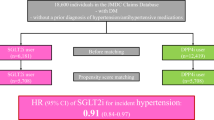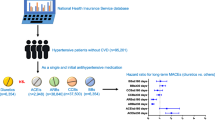Abstract
In the Valsartan Antihypertensive Long-Term Use Evaluation (VALUE) trial, the risk of new-onset diabetes was reported to be 23% lower among patients initiating therapy with valsartan versus amlodipine. The objective of our study was to examine whether this finding is generalizable to ‘real-world’ clinical practice. A retrospective cohort design and a large US health insurance database were employed for analyses. Study subjects included all hypertensive patients, aged ⩾35 years, who were free from diabetes and who initiated treatment with valsartan (n=9999) or amlodipine (n=18 698) between January 1999 and March 2005. Unadjusted absolute risks of diabetes were 21.4 (95% confidence interval (CI) 18.9–24.3) and 26.3 (95% CI 24.3–28.3) per 1000 patient-years for valsartan and amlodipine, respectively; the corresponding relative risk (RR) for valsartan was 0.82 (95% CI 0.70–0.94). Multivariate analyses – controlling for age, sex, presence of hypercholesterolemia, cardiovascular disease and kidney disease, and pretreatment medical care expenditures – yielded similar results (RR=0.79, 95% CI 0.68–0.92). Our study thus corroborates the finding from VALUE that diabetes risk is lower for patients who receive valsartan versus amlodipine, and extends this finding to a ‘real-world’ setting.
This is a preview of subscription content, access via your institution
Access options
Subscribe to this journal
Receive 12 digital issues and online access to articles
$119.00 per year
only $9.92 per issue
Buy this article
- Purchase on Springer Link
- Instant access to full article PDF
Prices may be subject to local taxes which are calculated during checkout


Similar content being viewed by others
References
Fields LE, Burt VL, Cutler JA, Hughes J, Roccella EJ, Sorlie P . The burden of adult hypertension in the United States: 1999–2000. Hypertension 2004; 44: 398–404.
Chobanian AV, Bakris GL, Black HR, Cushman WC, Green LA, Izzo JL et al. Seventh report of the joint national committee on prevention, detection, evaluation, and treatment of high blood pressure. Hypertension 2003; 42: 1206–1252.
Kannel WB . Risk stratification in hypertension: new insights from the Framingham Study. Am J Hypertension 2000; 13: 3S–10S.
Gress TW, Nieto FJ, Shahar E, Wofford MR, Brancati FL . Hypertension and antihypertensive therapy as risk factors for type II diabetes mellitus. N Engl J Med 2000; 342: 905–912.
Kannel WB . Blood pressure as a cardiovascular risk factor. JAMA 1996; 275: 1571–1576.
Bonora E, Kiechl S, Willeit J, Oberhollenzer F, Egger G, Meigs JB et al. Population-based incidence rates and risk factors for type II diabetes in white individuals. Diabetes 2004; 53: 1782–1789.
Verdecchia P, Reboldi G, Angeli F, Borgioni C, Gattobigio R, Filippucci L et al. Adverse prognostic significance of new diabetes in treated hypertensive subjects. Hypertension 2004; 43: 963–969.
Padwal R, Majumdar SR, Johnson JA, Varney J, McAlister FA . A systematic review of drug therapy to delay or prevent type II diabetes. Diabetes Care 2005; 28: 736–744.
Jandeleit-Dahm KA, Tikellis C, Reid CM, Johnston CI, Cooper ME . Why blockade of the renin–angiotensin system reduces the incidence of new-onset diabetes. J Hypertens 2005; 23: 463–473.
Julius S, Kjeldsen SE, Weber M, Brunner HR, Ekman S, Hansson L et al. Outcomes in hypertensive patients at high cardiovascular risk treated with regimens based on valsartan or amlodipine: the VALUE randomised trial. Lancet 2004; 363: 2022–2031.
Kjeldsen SE, Julius S, Mancia G, McInnes GT, Hua T, Weber MA et al. Effects of valsartan compared to amlodipine on preventing type II diabetes in high risk hypertensive patients: the VALUE trial. J Hypertens 2006; 24: 1405–1412.
Cardinal H, Tahami Monfared AA, Dorais M, LeLorier J . A comparison between persistence to therapy in ALLHAT and in everyday clinical practice: a generalizability issue. Can J Cardiol 2004; 20: 417–421.
Health Insurance Portability and Accountability Act of 1996, 42 USC §1320-d2. Available at: http://www.cms.hhs.gov/hipaageninfo/downloads/hipaalaw.pdf(accessed September 5, 2006).
Public Welfare – Protection of Human Subjects; 45CFR 46 §46.101. Available at: http://ohsr.od.nih.gov/guidelines/45cfr4(accessed September 5, 2006).
Julius S, Gudbrandsson T, Jamerson KA, Tariq SS, Andersson O . The hemodynamic link between insulin resistance and hypertension. J Hypertens 1991; 9: 983–986.
Carlsson P-O, Berne C, Jansson L . Angiotensin II and the endocrine pancreas: Effects on islet blood flow and insulin secretion in rats. Diabetologia 1998; 41: 127–133.
Sharma AM, Janke J, Gorzelniak K, Engeli S, Luft FC . Angiotensin blockade prevents type II diabetes by formation of fat cells. Hypertension 2002; 40: 609–611.
Acknowledgements
Funding for this research was provided by Novartis Pharma AG.
Author information
Authors and Affiliations
Corresponding author
Rights and permissions
About this article
Cite this article
Weycker, D., Edelsberg, J., Vincze, G. et al. Risk of diabetes in a real-world setting among patients initiating antihypertensive therapy with valsartan or amlodipine. J Hum Hypertens 21, 374–380 (2007). https://doi.org/10.1038/sj.jhh.1002159
Received:
Revised:
Accepted:
Published:
Issue Date:
DOI: https://doi.org/10.1038/sj.jhh.1002159



